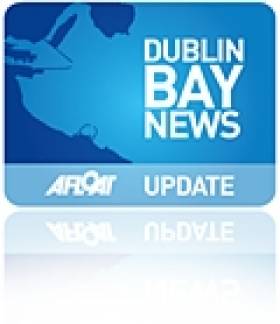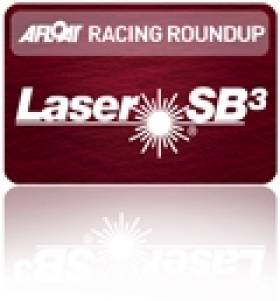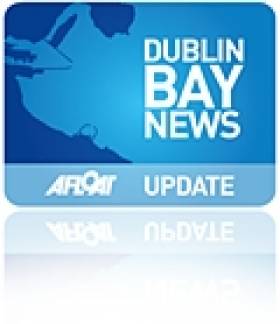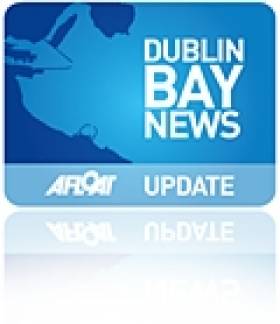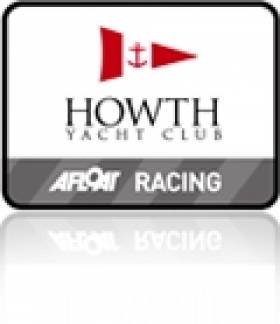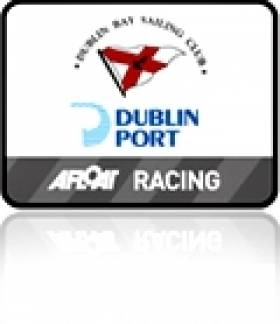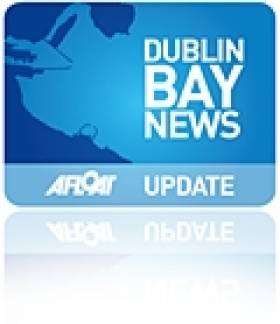Displaying items by tag: Dublin Bay
Four Championships (and a Mega Party) Planned for Dun Laoghaire 2011
A number of classes have already committed to run open championships within the regatta including the Wayfarer UK and Irish Nationals, the J109 Open Championship, the SB3 Open Championship and a return match of the Irish Sea Championship in J80s between Ireland and Wales. The race management team headed up by Con Murphy, aided by the usual ocean of wonderful volunteers, are working to facilitate this to ensure the kind of quality race management and organisation that will ensure the success of these championships.
The non-spinnaker fleet was the largest fleet in the Regatta in 2009 and is expected again to top the numbers and provide great racing for large boats with a smaller crew.
The regatta combines the wonderful waterfront facilities of all 4 Dun Laoghaire clubs and includes support from other clubs in the Dublin area including Howth. There will be a full on entertainment programme for all participants and many more with the continued support of many of the sponsors of 2009 which included Volvo Cars, Dublin Port, Dun Laoghaire Rathdown County Council, The Royal Marine Hotel, Helly Hansen, Dubarry and many more.
One of the highlights of the regatta are the Ladies Lunches which will again be held across a number of the clubs on the Saturday. Top Fashion, great food, a dash of style accompanies by the glass of champagne are the order of the day. All these at a very reasonable price reflecting the realities of today's tightened purse strings.
There will be more announcements in the coming weeks.
For more information visit www.dlregatta.org or event secretary Ciara Dowling at [email protected]
Ships Meet In Dublin Port: Recall Collision in Dublin Bay
As the ro-ro ferry Norcape departed Dublin Port last Monday, on a routine sailing to Liverpool, the vessel passed the docked general dry-cargo bulker Wilson Tana. The vessels were involved in a collision in Dublin Bay, over 20 years ago, writes Jehan Ashmore.
On 18 February 1988 the vessels collided about a mile off the entrance to Dublin Port. The Norcape, was then under different ownership as B+I Line's 6,310grt Tipperary and the 4,694grt Wilson Tana, then named Sumburgh Head was owned by Norwegian shipping company Christian Salvesen.
Several small craft dashed to the scene as part of the rescue effort, fortunately the incident occurred close to the port and without loss of life or injury.
The bow of the Tipperary ruptured one of the Sumburgh Head holds, causing a large gash in hold No. 3 that led to over 3,500 tons of fertiliser spilling into the sea. The vessel was carrying in total 5,000 tonnes of the cargo from Rostock, then in the former East Germany.
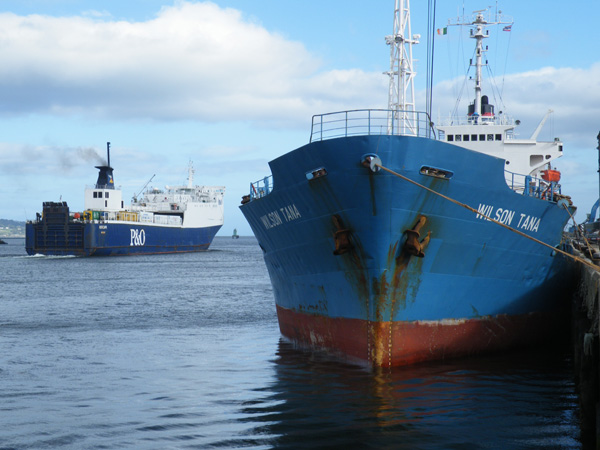
Norcape (formerly B+I Line's Tipperary) and Wilson Tana (formerly Sumburgh Head) in Dublin Port on Monday. Photo J. Ashmore /ShipSNAPS
Also arriving at the scene were tugs to assist the disabled vessels. The Sumburgh Head was in need of more urgent attention having sustained heavy structural damage amidships to one of four cargo holds. Several attempts were made to pull Sumburgh Head free while the Tipperary used her bow thrusters and main engines in an attempt to pull away too.
After an hour the vessels parted, though air-sea rescue services were called as it was feared the Sumburgh Head was in a vulnerable situation. The vessel only developed a 10-degree list and limped into the port under towage. Tipperary was less damaged and managed to return to port under her own power.
Sumburgh Head received remedial attention with metal girders positioned across the gapping damaged hold. In comparison the Tipperary was less damaged except for a gash to the bow and several buckled bulbous bow plates. The ferry received repairs in the local dry-dock facility in Alexandra Basin.
The Sumburgh Head was built in 1977 at the Hashihama Zosen shipyard, Imabari in Japan. Incidentally, Tipperary was also built in Japan by Mitsui Engineering Shipbuilding, Tamano and launched in 1979. The newbuild was chartered to B+I Line to serve on a new Dublin-Fleetwood route jointly operated with P&O, using Tipperary's sister, Ibex.
In 1988, the route's UK port switched to Liverpool with Tipperary remaining on the route until sold to North Sea Ferries in 1989 and renamed Norcape. It is only this year that the vessel returned to Dublin-Liverpool for P&O (Irish Sea) completing a career circle.
As for Wilson Tana, the Maltese flagged bulker docked in Dublin after arriving from Gijon, northern Spain. For the next two days the vessels cargo of sand was unloaded at the Coal Quay before departing last night.
Donnelly Wins Dun Laoghaire End of Season Oppy Event
SB3 'Open Day' Concept Goes National
What started out as local recruitment drive on Dublin Bay has widened with interest now reported nationwide for next weekend's Dun Laoghaire SB3 Open Day. Sailors are coming from Howth, Galway and Northern Ireland for test sails at the National YC. "We never imagined there would be so much interest from so many locations out side the Dun Laoghaire area" says class captain Justin Burke.
"Our original intention was to encourage local sailors to try out an SB3 but we will look after everyone. The bookings are coming in at a steady rate and everything thing is in place for a great day. We have racing , boat show , demos and video of the Worlds at Lake Garda", he added.
The Sports Boat concept is focused around close competitive racing on 40 minute courses in easily manoeuvrable one design boats. "You do not need a football team to race just 3 people. And above all they are fast. This is not cheque book racing. Everyone has the same boat same sails so it's all about the racing, Justin says.
Although this concept of racing is not new it is very much in tune with the modern life style where free time is at a premium and the prospect of getting 2 competitive races in 2 hours appeals to helm and crew .
Contact Justin Burke 087 2417542 or drop him a line at [email protected] with your name and number to book a test sail
Royal Navy Mine-Hunter to Visit Dublin
A courtesy visit by the Royal Navy's HMS Bangor (M106) is due in Dublin tomorrow. The mine counter-measure vessel is base-ported at HM Naval Base, Clyde, Scotland and is named after Bangor, the shoreside town on Belfast Lough.
For over 15 years, the 484-tonnes vessel has had a close affiliation with the Combined Cadet Force and Bangor Grammar School. In late June HMS Bangor returned to her namesake port to support Armed Forces Day celebrations which included the 150th anniversary of the Sea Cadets and to participate in the annual Sea Bangor Maritime Festival.
HMS Bangor is the ninth 'Sandown' class of Single Role Minehunters (SRMH) built by Vosper Thorneycroft, Woolston near Southampton. The glass-reinforced plastic (GRP) ship was launched in April 1999. The vessel has a crew of 34 and is fitted with an array of mine countermeasure equipment that includes decoy launchers and disposal systems.
In 2002 the vessel was deployed to the Gulf in Operation Telic, conducting mine clearance operations in Khawr Abd Allah ahead of humanitarian aid shipments which were ferried into the Iraqi port of Umm Qasr.
Howth Lifeboat Rescues Drowning Woman
The Lifeboat crew had been out on exercise when they spotted the 31 year old female struggling above the waves. She had sunk two feet beneath the water when the crew reached her. They managed to catch her clothing and pull her aboard the All Weather Lifeboat (ALB), immediately administering first aid.
The RNLI crew then took the lady safely to Howth harbour, as she was thought to be too distressed to be lifted by the Coastguard helicopter which was also in attendance. An awaiting ambulance brought her to Beaumont Hospital to recover.
Howth RNLI voluntary crewmember Dave Howard says:
"All the crew were relieved that this rescue had a positive ending, the lady would certainly have died had we not already been at sea on exercise. She was very lucky"
Related Safety posts
RNLI Lifeboats in Ireland
Safety News
Rescue News from RNLI Lifeboats in Ireland
Coast Guard News from Ireland
Water Safety News from Ireland
Marine Casualty Investigation Board News
Marine Warnings
Underwater Dublin Bay Survey to Start on Friday
Storm Threat in HYC League
HOWTH YACHT CLUB AUTUMN LEAGUE (RACE 2) 26/09/2010 Class 1 IRC: 1, Storm P Kelly HYC; 2, Crazy Horse Chambers/Reilly HYC; 3, Equinox R McDonald HYC; Class 1 ECHO: 1, Storm P Kelly HYC; 2, Equinox R McDonald HYC; 3, Makutu Newman/Others HYC; Class 2 IRC: 1, Kinetic Colwell/Murphy HYC; 2, King One D Cullen HYC; 3, MiniMumm Cobbe/McDonald HYC; Class 2 ECHO: 1, Kinetic Colwell/Murphy HYC; 2, MiniMumm Cobbe/McDonald HYC; 3, King One D Cullen HYC; Class 3 IRC: 1, Alliance V Gaffney HYC; 2, Gecko K Darmody HYC; 3, Holly B MacMahon HYC; Class 3 ECHO: 1, Gecko K Darmody HYC; 2, Rossinver C Scott HYC; 3, Starlet E Bourke HYC; Class 4 ECHO: 1, On the Rox C & J Boyle HYC; 2, Flashback Hogg/Others HYC; 3, Bite the Bullet C Bermingham HYC; Class 4 IRC: 1, Flashback Hogg/Others HYC; 2, Bite the Bullet C Bermingham HYC; 3, Trinculo M Fleming HYC; Class 5 ECHO: 1, Demelza Ennis/Laudan HYC; 2, Voyager J Carton HYC; 3, Force Five R & J McAllister HYC; Class 5 IRC: 1, Voyager J Carton HYC; 2, Alphida H Byrne HYC; 3, Force Five R & J McAllister HYC; Puppeteer SCRATCH: 1, Harlequin Clarke/Egan HYC; 2, Yellow Peril N Murphy HYC; 3, Gold Dust Walls/Browne HYC; Puppeteer HPH: 1, Yellow Peril N Murphy HYC; 2, Ghosty Ned D Harkin HYC; 3, Harlequin Clarke/Egan HYC; Squib SCRATCH: 1, Kerfuffle Craig/Raune HYC; 2, Klipbok E Dalton HYC; 3, Shadowfax P Merry HYC; Squib HPH: 1, Kerfuffle Craig/Raune HYC; 2, Klipbok E Dalton HYC; 3, Shadowfax P Merry HYC; 17 Footer SCRATCH: 1, Aura I Malcolm HYC; 2, Rita Lynch/Curley HYC; 3, Deilginis Delginis Group HYC; 17 Footer HPH: 1, Aura I Malcolm HYC; 2, Deilginis Delginis Group HYC; 3, Rita Lynch/Curley HYC; Etchells SCRATCH: 1, Fuzzy Duck B O'Neill HYC; 2, Kootamundra O'Grady/Reilly HYC; 3, Northside Dragon J Bourke RStGYC; J 24 SCRATCH: 1, Jibberish O'Kelly/Others HYC; 2, Scandal B McDowell MYC; 3, Hard on Port F O'Driscoll RStGYC
WOW is First Home in Cruisers Zero DBSC Race
BENETEAU 31.7 Echo- 1. Thirty Something (Gerry Jones et al), 2. Violet Flame (B.Murphy/L.Osbourne), 3. Extreme Reality (P.McSwiney/E.O'Rafferty)
BENETEAU 31.7 - 1. Thirty Something (Gerry Jones et al), 2. Violet Flame (B.Murphy/L.Osbourne), 3. Levante (B.Leyden/M.Leahy)
CRUISERS 0 Echo - 1. Tsunami (Vincent Farrell), 2. WOW (George Sisk), 3. Lively Lady (Derek Martin)
CRUISERS 0 - 1. WOW (George Sisk), 2. Tsunami (Vincent Farrell), 3. Lively Lady (Derek Martin)
CRUISERS 1 Echo - 1. Xtravagance (Colin Byrne), 2. Indecision (Declan Hayes et al), 3. Jetstream (Peter Redden)
CRUISERS 1 - 1. Xtravagance (Colin Byrne), 2. Jalapeno (Dermod Baker et al), 3. Gringo (Tony Fox)
CRUISERS 2 Echo - 1. Jawesome 11 (V.Kennedy/M.Dyke), 2. Red Rhum (J Nicholson), 3. Peridot (Jim McCann et al)
CRUISERS 2 - 1. Jawesome 11 (V.Kennedy/M.Dyke), 2. Red Rhum (J Nicholson), 3. Bendemeer (Gerald Kinsella)
CRUISERS 3 Echo - 1. Gung Ho (G & S O'Shea), 2. Jammie Dodger (J.H & D.O'Neill), 3. Supernova (K.Lawless et al)
CRUISERS 3 - 1. Supernova (K.Lawless et al), 2. Gung Ho (G & S O'Shea), 3. Two Step (Ross Doyle)
GLEN - 1. Glenluce (D & R O'Connor), 2. Pterodactyl (R & D McCaffrey), 3. Glencree (J.Bligh/H.Roche)
IDRA 14 FOOT Race 1- 1. Dunmoanin (Frank Hamilton), 2. Squalls (Stephen Harrison), 3. Diane (F & M O'Flaherty)
IDRA 14 FOOT Race 2- 1. Sapphire (Lorcan O'Sullivan), 2. Diane (F & M O'Flaherty), 3. Squalls (Stephen Harrison)
MERMAID Race 1- 1. Lively Lady (G O'Neill & M Hanney), 2. Kim (D Cassidy), 3. Oonagh (J&M Griffith)
MERMAID Race 2- 1. Lively Lady (G O'Neill & M Hanney), 2. Kim (D Cassidy), 3. Oonagh (J&M Griffith)
RUFFIAN 23 - 1. Diane ll (Bruce Carswell), 2. Alias (D.Meeke/M.McCarthy), 3. Ruff N Ready (Ann Kirwan et al)
SHIPMAN - 1. Gusto (C Heath), 2. Whiterock (Henry Robinson), 3. Euphanzel lll (Louis McSherry et al)
SIGMA 33 - 1. White Mischief (Timothy Goodbody), 2. Rupert (R.Lovegrove/P.Varian), 3. Popje (Ted McCourt)
WHITE SAIL CRUISERS Echo - 1. Lucy O (Aonghus O hEocha), 2. Fortitudine (D & A Clarke), 3. Coumeenole (Bill Kavanagh)
WHITE SAIL CRUISERS - 1. Xerxes (Dan O'Neill), 2. Act Two (Michael O'Leary et al), 3. Windshift (R O'Flynn et al)




























